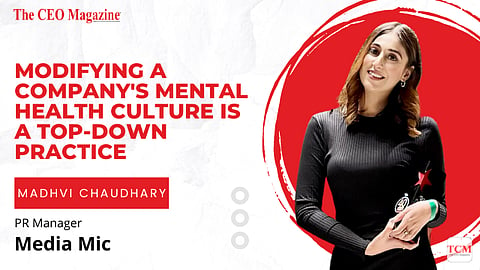
- News
- Women
- Magazine
- IndustryIndustry
- InsightsInsights
- Success Stories
- PublishPublish
- ContactContact
- Media KitMedia Kit

Beginning with the facts, According to Mental Health America's Mind the Workplace report for 2021, nearly 83 percent of respondents felt emotionally drained at work. And 85 percent, or about nine out of ten workers, said job stress harmed their mental health. And it would not be incorrect to say that the pandemic years have only exacerbated these facts and figures. However, we can say that the only silver lining amid all the upheaval and trauma is the normalization of mental health issues at work. But is it working?
Employers have responded with initiatives such as mental health days or weeks, four-day workweeks, and enhanced counseling benefits or apps, but these are insufficient. Employees demand and expect emotionally healthful workplaces, which necessitates tackling the difficult task of a cultural shift. It is not enough to provide the most recent apps or use figures of speech such as "well-being" or "mental fitness." Employers must link what they say to what they do.
Leaders play a critical role in fostering a mental wellness culture. Because of the massive workforce shortages caused by Covid-19, employee emotional health has risen to the surface. According to a study published in The Lancet, mental health disorders account for 18% of the global disease burden and will cost the economy $6 trillion by 2030. In addition, employees in the United States are quitting their jobs in record numbers due to the Great Resignation. According to McKinsey and Company, 15% of the unemployed blamed their inability to work on mental health issues.
Tick-the-box solutions provided by talent acquisition departments, such as employee assistance programs and mental health policies, will not solve the problem. Having robust mental health benefits is essential, but it is not sufficient. Employees must not only be given clear information about where to go or who to contact for mental health support, but they must also not be afraid of being stigmatized for seeking it. Unfortunately, this happens far too frequently.
Finally, the company's mental health culture reduces stigma and empowers employees to access mental health benefits. Leaders shape the culture of their organizations. Changing a company's mental health culture begins at the top.
Workplace anxiety is common, but it can be easily managed. Understanding your stressors, setting limits, and taking regenerative breaks are all examples of small steps that can go a long way.
However, if your work stress becomes too much for you to handle on your own, don't be afraid to seek professional help. A therapist can always provide compassionate assistance in identifying potential causes and exploring your options for dealing with them. Above all, keep in mind that you deserve to work in a safe and acceptable environment.
Follow us on Google News
